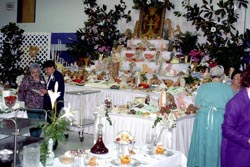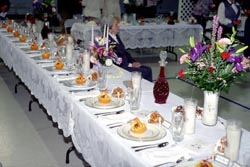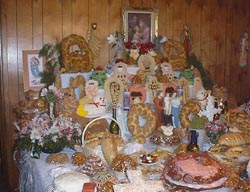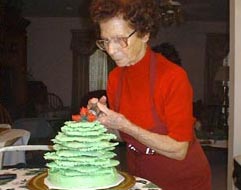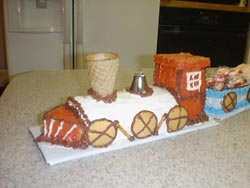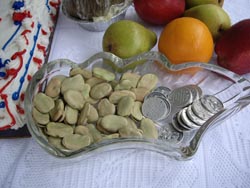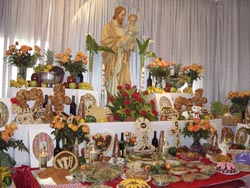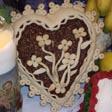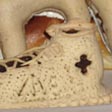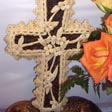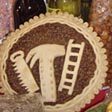Italian Traditions in Independence, Louisiana
By Laura Westbrook
Introduction
Citizens of Italian descent comprise a significant percentage of South Louisiana's total population, and have had a tremendous impact on Louisiana culture, from architectural masonry to foodways to jazz and brass band music. In Independence, the proportion of Italian residents is conspicuous in that Italian-Americans outnumber any other cultural group. Many of these are first-generation Italian-Americans, their parents having emigrated at the turn of the century from southern Italy-Apulia, Calabria, and primarily Sicily. Italian emigrants to Louisiana typically arrived at the Port of New Orleans and quickly found work, often as plantation workers replacing the newly freed slaves. As soon as possible, they sent for the rest of the family, and children worked alongside their parents in the cane fields.
Attracted by the developing strawberry industry in Tangipahoa Parish, many frugal southern Italians eventually purchased land there, centering in Independence (called "Uncle Sam" until 1852) and extending northward into Amite and southward into Hammond. On arrival, they were met with suspicion by other European emigrants, northern Italians among them. In larger Louisiana cities, some upscale restaurants still specify that they serve "northern Italian cuisine," to distinguish themselves from the "peasant" food of southern Italy. Early difficulties in assimilation strengthened the close community bonds among southern Italians in Tangipahoa Parish. The religious and secular traditions and rituals served to keep the community close. Among the first settlers were family names still familiar in Independence: Alessi, Anzalone, Genovese, Levatino, Miceli, Pecoraro, Sinagra, Tiaravella, Zabbia.
Though southern Italians and their descendants now indicate that they feel no cultural stigma living in Louisiana, many continue to uphold traditions that serve as reinforcers and celebrations of cultural identity. Italian communities throughout the state celebrate their heritage through Italian cultural festivals, and Independence holds an annual Italian Festival as well (the last weekend of April). Restaurants that serve southern Italian cuisine are increasingly popular in cities like New Orleans and Baton Rouge, and increasingly feature such age-old dishes as polenta, while Gina's Restaurant in Independence attracts visitors from both of those cities, and throughout the parish.
This survey gives a preliminary account of Independence's history and traditions. A more in-depth report that suggests avenues for further research is available. Its descriptions primarily focus on foodways traditions in Independence as they relate to family and religious life, and particularly as they are practiced in preparation for St. Joseph's Day (March 19).
A Brief Sketch Of Italians In Independence
Sicilian immigrants first came to Independence in the 1890s to work as strawberry laborers. Many began as pickers working for $1.50 to $1.75 per day, and within a few years saved enough from their wages to buy their own twenty-acre farms for approximately forty dollars an acre. By 1920, the Italian population constituted just under ten per cent of the total population of Tangipahoa Parish.
Independence Italians continued to operate strawberry farms, and by 1905, Independence had become Louisiana's primary shipping center for strawberries. By 1910, Italians and their children represented the majority of the town's population. Expanding their endeavors beyond berry farming, the Italians invested in businesses, small factories, and in an electric power plant. They also took an active role in the creation of strawberry farmers' associations, working with other Sicilians and native Americans, which helped Louisiana to become the leading strawberry-producing state throughout the 1920s.
Independence Italians continued to observe many aspects of traditional Sicilian life. One of the ways in which a sense of community was preserved was with the establishment of mutual aid societies that assisted the new citizens in adjusting to American life. These groups were politically active and agitated for such things as new transportation routes, and they also served as springboards for Italians who wished to enter public life. Huey Long's tenure saw the largest increase of Italian and other "ethnic" politicians in Louisiana, and during this time Independence politicians moved from positions such as aldermen and mayors, police jurors, and school board members to become state representatives and to move further into the political mainstream.
Independence has produced some notable politicians, among them state representatives Charles Anzalone, Frank Anzalone, and Buster Gazzardo, and its own government has largely been by Italian office-holders, such as mayors Charles Anzalone, Charles Maretta, Vincent Vacano, Charles Sinagra, John LaRock, and Phillip Damiano.
Many of Independence's younger Italian Americans find it necessary to move to nearby Hammond, Baton Rouge, or New Orleans for professional reasons, but family and religious gatherings draw them back home on weekends.
Independence residents with firsthand recollections of strawberry farming & the strawberry industry include Conchetta "Chetta" Frusina and Victoria Navarro. Buster Guzzardo can tell stories about politics in Independence, and Independence politicians in state government.
Italian American Social Life And Gathering Places
Aside from family gatherings, Mater Dolorosa Catholic Church is the primary place where Italian families gather in Independence. In addition to its regular mass schedule, the church sponsors social and community events. A number of other organizations boast a sizeable number of Independence citizens of Italian descent. The Knights of Columbus, which comprises a men's club and a ladies' auxiliary, sponsors monthly family social events. The American Legion Hall hosts holiday and special events, and its members observe special occasions, such as Memorial Day, as a group. The Lion's Club and the Chamber of Commerce are also active organizations within the community. The Saint Joseph's Society organizes the public festivities and observances that are held on that day, working with the large group of women, men, and children who help to prepare the community altar and meal. Some citizens who are active in the community and interested in their Italian heritage would like to establish an Independence branch of the large Italian Club headquartered in Slidell.
Italian Folklife in Independence
Many residents nostalgically remember the days when family gatherings featured a roasted calf or pig cooked in an outdoor "mud" (actually clay and brick) oven, and children were allowed to roast their own sweet potatoes in the coals. Most of these recollect the voices of their parents telling stories of Italy, inspired by the locally-produced Italian music of the Independence Brass Band, the Sonny Starnes Band, or the Peerless Revelers Orchestra (all now defunct). Until about a decade ago, the St. Joseph's Day procession would begin with a band concert, after which the band would march through town, stopping at local businesses and homes to honor those active in the St. Joseph's Society. Others tell of the amazing holiday fireworks displays created by the Lamaraca family. Assimilation, migration, and changing social patterns have contributed to the demise of these customs, but residents value the traditions that are still practiced, and wish to pass them on.
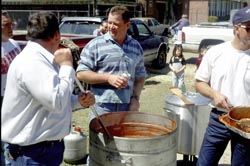
The Independence Museum attempts to collect and exhibit artifacts relevant to Independence history and culture. Housed in the former Mater Dolorosa Church building, organizers are in the process of collecting funds for appropriate storage and display.
Italian traditions are celebrated each year at the Independence Italian Festival, also called the Little Italy Festival, which takes place annually on the last weekend in April. The festival opens with an invocation by the priest, and includes mass on Sunday. Festival organizers hope to present Italian music each year and several festivals have featured a replica St. Joseph's altar in the old Mater Dolorosa Catholic Church, now the Italian Cultural Museum. Every festival features a variety of Italian foods for sale, and food is celebrated in other ways as well, such as with a spaghetti-eating contest. Activities include locally written plays, displays of talent from local dance or acrobatic classes and cheerleaders/drill teams, carnival-type attractions, a parade featuring an honored (usually local) Grand Marshal, and a beauty pageant. The program book is notable for its inclusion of several family histories and recipes each year.
Family Traditions
Henry Maretta, at 81, remembered that when he was six years old, he would wake up with his mother at two o'clock in the morning so he could help her bake bread in the family's outdoor oven. His mother would let him knead the dough after it was mixed. He also prepared the oven, stoking the fire and removing the coals. An experienced cook, his mother knew when the temperature was right for baking simply by the feel of the oven. As in many other families, this ritual was repeated about twice a week. Each batch produced about twenty-five loaves of bread for family use.
Each week, the extended family would gather for Sunday dinner after church. The younger cousins would play boisterously in the yard while older relatives caught up on current community events and several women prepared an elaborate meal. At dinnertime, the children would become quiet as places were taken at the table. All eyes would be on the head of the family until grace was said and the first bite of food was taken. This was the signal to begin the meal, which often featured a roasted deer or pig.
Mr. Maretta's recollections are common to most Independence citizens of his generation, and to the generation or so that followed his. Many adults repeat similar stories of the family and community life they fondly remember. Adults report that, as children, they played bocce ball and other games that are rarely played in Independence today.
Wedding customs were a bit different in the recent past, according to Victoria "Miss Vic" Navarro. She recalls that brides could bring themselves extra luck by serving peanuts at their weddings. Victoria Candiotto adds that many wedding traditions are still practiced today, such as "pulls" in the bride's cake. The "pulls" are brightly-colored ribbons that have one end in the wedding cake (usually the bottom layer) and the other end arranged on the serving table. The close female friends of the bride, generally the bridesmaids if the wedding is large, each choose a ribbon and gently pull it out of the cake, revealing a token or charm that has been tied to the other end. The token is said to tell the woman's fortune-a ring means that she will be married soon, etc. People still talk about a wedding several years ago in which the wealthy parents of the bride added neatly packaged gifts of money to the traditional tokens. In addition to peanuts, Independence weddings still customarily feature a meatless buffet or meal of fruits, vegetables and seafood, strawberry wine, and cookies-fig, cicilene (sesame seed cookies), and chocolate balls.
Foodways
An inventory of Independence folklife, conducted by Regional Folklorist Laura Westbrook, revealed an abundance of food traditions, from producing and processing to preparing to presenting and consuming. Among families in which traditional handicrafts, such as needlework, have been lost, food traditions are still strong. Food traditions remain important in private life as well as in social gatherings and religious occasions. The variety of Italian foodways ranges from herb, fruit and vegetable gardening to the curing of vegetables and the making of wine, to various forms of socialization which feature food consumption (family dinners to traditional wedding feasts to sacred ritual foods). Not surprisingly, given Independence's beginnings, many of its Italian families are involved in some aspect of food production or distribution, from growing and canning fruits and vegetables, to running produce companies or wineries, to operating grocery stores or restaurants. Italians in nearby communities also operate seafood-processing and distribution companies and New Orleans-area Italians supply many of its restaurants with seafood and fresh produce.
Most families preserve traditional recipes; the importance of Italian family recipes can be seen in the proud publication of family recipes in the annual Italian Festival guide. Each recipe is accompanied by the name of the contributor, and sometimes by a short narrative about the dish and its importance to the family. Great store is set on traditional recipes, especially those that can be traced to a family home in Italy. Some of the special cooking processes were brought over by a parent and passed on to their children, such as Angelo Mannino's methods for processing home-made sausage, or John Labate's wine-making techniques. Every family has its own recipe for such favorites as the distinctively sweet red sauce favored in Sicily and southern Italy. Many of the older ladies, and some men, continue to make their own pasta, which is often egg-based. Seafood dishes are perfected throughout the year, and can be served during Lent, as seafood is not considered meat. Although Independence is not a fishing community, its citizens enjoy easy access to shrimp, crabs, oysters, and fish of many varieties through area distributors and fishermen, many of whom are Italian. Traditional fruit and vegetable recipes benefit from fresh local produce. Each family has special dishes for festive occasions such as Christmas, Easter, saints' days, and Thanksgiving, although a traditional pasta dish or soup may be followed with fried chicken or a baked turkey. Every cook has a preferred method and recipe, and these are discussed with great interest wherever cooks gather.
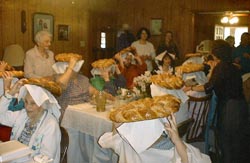
Italian festive sweets include cudureddi, sfingi or sphingi (cream puffs), and cassadini (sweet ravioli), spumoni (ice cream with different-flavored & colored layers, sometimes with fruit and/or nuts), and many types of cookies. Main dishes include brucciloni (rolled stuffed steak served with red gravy), chicken or rabbit cacciatore, calamari (squid, fried or served with pasta and red gravy), lasagna, and spaghetti a la Siciliana; main or side dishes include peperonata (Italian ratatouille), froschias or frittatas (omelets with fillings beaten into the eggs), copolatina (eggplant in red sauce with green olives, celery, capers, and garlic), stuffed cabbage, polenta (cornmeal boiled in water or stock), bruschetta (grilled bread drizzled with olive oil & garlic, and/or tomato, basil, and parmesan), panzanella (tomato & bread salad), olive salad, stuffed artichokes and artichoke soup. Family gatherings occasion welcome opportunities for cooks to exercise the full range of their culinary skills. Most of the women who make increasingly rare dishes, such as copalitina, welcome the chance to pass them along to younger cooks. Conchetta "Chetta" Frusina's Italian bread is locally renowned, and she expresses some apprehension that younger cooks may not continue to make their own bread. Says Chetta, "You know what bread is? Patience!" Mrs. Frusina's Italian bread, flap-jacks, and copalitina are family favorites, as are fried peppers or fried okra, strips of green onions (or okra) cooked down in a skillet with yellow onions, to which beaten egg has been added. Mrs. Frusina cooks for her family on Sunday afternoons, but the gatherings are not as large as the ones she remembers from her childhood.
For this project, interviews were conducted with many of the renowned Italian cooks in Independence, among them Victoria Candiotto, Conchetta "Chetta" Frusina, Josephine "Ma Phine" Messina, Tony Jean Catalano, and Rose Levatino.
Restaurants
Two notable restaurants developed to serve the lunch crowd and visitors who wish to sample the local cuisine. One of these is Blaise's Restaurant, run by Diane Navarro, whose combination of thick, iced pastry rolled around a spicy fig filling has developed a growing reputation. Over time, the popularity of her cookies eclipsed restaurant sales. The restaurant eventually dropped meal service altogether, and concentrate exclusively on the cookies.
This has left Gina's Restaurant, an Independence institution, as the primary source for purchasing distinctive local dishes. The historic downtown building at 319 4th Street is named for owners Reggie and Cindy Martin's daughter Regina. The whole family works at the restaurant, and Reggie hopes that one day his son Jason might want to take over the store. The popular restaurant's clientele includes all of Independence, and regular visitors from as far away as Baton Rouge. Reggie's mother-in-law, the locally acclaimed cook Rose Levatino, also works in the kitchen and is teaching Gina Martin her techniques. Rose says the restaurant's biggest secret is that Reggie actually prepares the sweet Italian red sauce for which the restaurant is so renowned. (They both know that people assume she is the red-sauce chef.) Reggie's favorite cooking accomplishment is his Italian rolls. To his knowledge, he is the only cook in Independence who still makes the heavy rolls the old-fashioned way. The restaurant's most popular dish is its spaghetti and meatballs.
Mike's Café serves some Italian dishes cooked by Mike's mother, the highly regarded local cook Josephine Valardo. Although the menu at Mike's runs primarily to American lunch foods, the lasagna and homemade pizza are popular with regulars.
Bakeries
Italian American bakeries offer Italian crusty bread, braided or in round or narrow loaves, and sweets such as cannoli (fried pastry roll with a sweet cream filling) and biscotti (crisp crescents flavored with anise and often containing almonds or filberts), marsala cakes and a variety of Italian cookies.
A few Italians, like Mrs. Frusina, prefer to make their own bread at home. Guy and Bernadette Labate have an outdoor oven in which they have baked bread in the past. Guy, who feels that his oven "burns hot," plans to build another oven in the future. Both Mr. and Mrs. Labate learned the art of mud oven cooking as children, first watching and then being allowed to take part in food preparation. Guy's brother John Labate, who often entertains large groups of family and friends, also plans to build an outdoor oven.
Italian cookies are made and sold on location at Blaise's, and are packaged for shipping to Baton Rouge, New Orleans, and some Florida towns. In addition to its popular spicy fig cookies, Blaise's makes Italian chocolate, sesame seed, and anise cookies as well as orange, banana, thumb print, walnut, almond, and snowball cookies.
Those who wish to purchase Italian baked goods like cookies and cakes, confetti (Jordan almonds), anise oil or ingredients for the rare "ammonia cookies," or accessories such as plastic figurines for wedding or communion cakes, can do so at Mama Alessi's.
Italian Markets
There are no specifically Italian food or specialty stores in the area, but there are a few stores that sell items of special interest to the local Italian community. The stores listed below all sell Italian wines, as do several of the area's chain supermarkets. These stores also sell Italian olives and olive oils, Italian sausages, crusty Italian breads and some other bakery items, and ingredients for Italian recipes, such as pastas and cheeses. The influence of Italian foodways has been so strong in South Louisiana cooking, particularly in the larger cities, that a wide range of pastas, cheeses, oils, and other ingredients necessary to Italian recipes can be found at many large supermarkets throughout the area.
Home-made Italian sausage is produced at the White Tail Butcher Shop by Angelo Mannino, whose father taught him the techniques he had learned as a young man in Sicily. He still uses his father's recipe for Italian sausage, and also prepares smoked sausage, green onion sausage, breakfast links, and Cajun-style sausage. He was the first in the Independence area to process deer, wild pig, and alligator meat, and these are the only types of meat he uses. Demand is such that he works in his backyard butcher shop almost every evening after work, by himself or with sons Brian and Scott. Any of his sausages can be purchased fresh, directly from Mr. Mannino.
Italians in the neighboring community of Amite are leaders in oyster processing and distribution. The three leading area oyster processors and suppliers areTony V's, Carlo's "Big R Brand" Oysters, Inc. and Joey Oyster, Inc.
Gardens
The Italian contribution to Louisiana agriculture is well-known. Locally, there are Liuzza's and smaller truck-farming enterprises such as Patanella's Produce Farms. Individuals continue to grow herb and vegetable gardens, and discussions of gardening challenges and techniques spring up at almost any gathering during the season. No longer the primary source for family meals, home gardens provide supplementary fruits, vegetables, and herbs. A typical backyard garden may consist of yard beans, snap beans, tomatoes, peppers, eggplant, okra, figs, pears, and muscadines. Herb gardens allow for less expensive, fresher herbs such as broad-leaf Italian parsley, oregano, rosemary, and finocchio (fennel). Many Italians also continue to tend small strawberry patches as well. Independence traditional gardeners who were interviewed for this project include Guy and Bernadette Labate, Dominick Maniscolo, Phillip Domiano, Sara Labate, and Josie Calcagno.
Produce merchants in the area include Liuzza Produce Farm, Inc., Arnone's Farm, Domiano Farms, Inc., Independence Produce, Lumino Farms, Tony Misita & Son Produce, and Patanella's Produce Farms.
Winemaking
A few Independence residents still make wine for home consumption in the traditional way. Notable among these is Mr. John Labate, whose garden produces ingredients for many of the fruit wines he makes "from scratch." John's parents came to Independence from Italy, where Joseph Labate was a wine-maker. He continued to make wine at home in America, and he taught his son John his methods. John has passed that knowledge on to his own son Joseph, who lives next door and monitors the process when John is away. John Labate has inherited a singular gift for wine-making-in addition to the locally favored strawberry and traditional raisin wines, he can make wine from plums, apricots, peaches, pineapples, blueberries, figs, cherries, watermelons, and even coconuts. John has a shed behind his home where he makes his wine for home use only. He never sells his wine, although he donates large quantities to the local St. Joseph's altar or to anyone who makes a special request, and he gives the rest as gifts.
Independence also boasts a commercial winery, Amato's. It is operated by Henry and Jessie Amato, and produces traditional drinking and cooking wines as well as many fruit wines such as blackberry, blueberry and strawberry. Amato's also produces special holiday wines and such specialty wines as shittake mushroom cooking wine.
Feast Days
Though families may celebrate the feast day of any particular saint, there are five larger, community-wide celebrations of this type. The largest observation, brought by Sicilian ancestors, is of St. Joseph's Day. This celebration commemorates legendary events, but is a vital, living tradition in that celebrants gather to thank St. Joseph for favors received during the past year (usually health-related).
A major purpose of the day is the feeding of area poor, in recognition of the continued agricultural good fortune that Italians see as stemming from the end of a fabled famine (though historians are unable to point to a specific famine or drought that might have occasioned the story). Legend relates that Italians, grateful to St. Joseph for the rains that nourished long-awaited new crops, promised to feed others who were poor and hungry with food from altars erected in his name. In this way, worshippers became obligated to feed the poor, and most modern altar-builders acknowledge this obligation. During past hard times in Sicily, the hardy fava bean helped keep many farmers alive, and today they are often given to altar visitors as "lucky" beans. Some say that fava beans were once only raised as food for cattle, adding to the poignancy of the farmers' hunger. This legend may have evolved in the United States, since current St. Joseph's Day celebrants in Sicily seem to practice a more customary saint's feast, and they do not seem to tell the legend about honoring St. Joseph with a food-laden altar. However, in other respects (such as giving to the poor) Louisiana and Sicilian contemporary practices of the tradition are very similar.
Older community members remember the days when there were as many as thirty or forty St. Joseph's altars in Independence and the surrounding area. It was common for area Catholics to "make the rounds," visiting as many as fifteen altars in a day or two. Today there are about half that number in any given year. Householders who gave altars would put magnolia leaves in an area where they could be easily seen by passersby, such as on the mailbox, indicating that visitors were welcome to enter the house and view the altar. This tradition continues today, although many residents who once enjoyed hosting an altar hesitate to do so now because of a fear of strangers. Though Independence is still a small town, it is no longer possible to know virtually everyone in town, in the way older inhabitants remember from their childhoods. Others are not bothered by the thought of outsiders in their homes. Says Annie Accardo, who leads the recitation of the Italian rosary for the large community ceremony, "I never minded strangers coming into my house when I had an altar. My house doesn't belong to me, anyway. I'm just borrowing my house from Jesus, and that means it's open to everybody!"
Several area chapels are known for their feast days as well. These are the St. Expedito Chapel on Brickyard Road, Mother of Grace Chapel near Tikfaw, Our Lady of Perpetual Help, and St. John the Baptist.
Some Historical Notes On St. Joseph's Day
In 1911, a church in Bologna, Italy became the first to be dedicated to St. Joseph. At this time, the unofficial feast day for Joseph was just before Easter. It was not until the fifteenth century (under Pope Sixtus IV, 1471-1484) that St. Joseph's feast day was officially designated as March 19th on the Franciscan calendar, a date just before the vernal equinox so important to pre-Christian agricultural societies. As the patron saint of workers, he is also honored on May 1. In 1726 Benedict XIII added Joseph's name to the Litany of the Saints, and in 1870 Pius IX named Joseph the patron saint of the Roman Catholic Church. The twentieth century saw a dramatic increase in prayers and honors offered to St. Joseph.
Among the Sicilian immigrants who immigrated to Louisiana, primarily settling in New Orleans, were families from villages like Contessa Entellina who identified themselves as Arbreshe, rather than as Sicilian or Italian. These families were descendents of Giorgio Kastriotta and his followers, who arrived in Sicily in 1448. Kastriotta was an Albanian who, kidnapped as a child by invading Turks, rose to prominence in the Turkish army and turned against the Turks, allying himself with Naples and Venice under papal blessing. In thanks, the king of Naples rewarded the Albanians with land in Sicily. These Arbreshe never assimilated in Sicily, and though Americans lumped all the emigrants together as "Sicilians" or "Italians," they continued to observe their own Byzantine Catholicism and in 1886 founded the exclusive Societa Italiana di Beneficenza Contessa Entellina in New Orleans, whose membership still includes only descendants of the village.
Although there are few, if any, descendents of the original Arbreshe in Independence, the group is worth noting because both the Arbreshe and Sicilian Americans have established a claim to the development of the St. Joseph's Day traditions that continue to grow and change today. It is likely that there is truth in both claims. Prior to the advent of Christianity, a spring festival was observed at the time of the vernal equinox that celebrated the season of renewal and expressed the hope for an abundant growing season. St. Joseph's Day observance, coming as it did just prior to the vernal equinox, adapted some of the symbolism of earlier agricultural and fertility rituals. In this way, a time of prayers for productive animal and agricultural husbandry became the date for honoring the earthly father of Christ in the Catholic church.
Strains of this seasonal fertility prayer and celebration can be seen in some of the existing traditions, such as in the sacred egg or seed which early Christians re-designated to be the seed of Christianity, or even of Mary's womb. For Sicilians, St. Joseph's Day is considered the first allowable day of spring planting. Many Sicilian-Americans hold this belief as well, since the climates of Sicily and South Louisiana are similar. It is no surprise, then, that the symbol for St. Joseph's Day is an as-yet-unplanted bean, or that this saint is honored in gratitude for, and with the fruits of, a bountiful harvest.
St. Joseph's Day is also the one day during Lent on which some Lenten requirements may be lifted. Traditionally, Catholics have been allowed to marry on St. Joseph's Day, but not on any other day during Lent. In some communities, St. Joseph's Day is often a day of frivolity. As in Sicilian cities, the day is spent feasting and partying in many Louisiana towns; sometimes the day's events end in a masquerade or ball. Some communities organize extravagant St. Joseph's Day parades featuring floats shaped as crosses and altars, but also including "marching clubs" of men who trade paper flowers for kisses from female bystanders, or even toss pairs of ladies' panties decorated with designs such as the Italian flag. The remnants of fertility rites (the kiss results in a flower) with overlays of more modern religious practice is striking in these celebrations.
The "parade" held on the afternoon of St. Joseph's Day in Independence is strictly a religious procession incorporating none of the common secular elements. It follows the community meal and free concert, after which a group of altar organizers break down the altar and decide which items will be donated and which will be given to high bidders or honored guests. When the "parade" passes, several volunteers leave their tasks to take part in the ritual prayers before returning to their work. In this way, the parade functions as a call away from the light musical interlude and post-concert visiting, back to the prayer and austerity of Lent.
Prayers to St. Joseph
Sicilian-Americans sing a special rosary to St. Joseph, as do Italian Sicilians of today. American Italians use a regular chaplet or rosary or pray on the cross of a rosary but in Sicily, there is a special ten-bead chaplet for singing the Sangiusipuzzi. Some people use parts of the St. Joseph's prayer along with the Lord's Prayer, and may incorporate parts of other prayers.
In Independence today, the St. Joseph's prayer is taught phonetically to children, but some of the people involved with St. Joseph's festivities are hoping to find someone who knows Sicilian and can teach them the prayer as it was meant to be sung. Here is a rosary text in Sicilian, followed by a translation provided by Rafaella Maggiore of Kenner (collected by Ethelyn Orso), and the text of the prayer recited in Independence.
Lu Rosariu di San Giuseppi / The Rosary of St. Joseph
Diu ti salvi San Giuseppi
Tuttu chinu di purita
Aiutatinni a li bisogni
a li stremi nicisita. (se repete 10 volte)
Sangiusipuzzi fustivu patri,
fustivu virgini comu la matri
Maria e la rosa, Giuseppi lu ggigghu
Datimi aiuta riparu e cunsigghiu.
Primu di l'arma e pi du lu corpu
datinni aiuta, riparu e confortu
scura oi e agghiorna dumani
la pruvvidenza na aviti a mannari.
God Hail you St. Joseph
all full of purity.
Help us in our need
and in our extreme necessities. (repeat 10 times)
Dear little sweet St. Joseph, you were a father;
you were a virgin like the Mother.
Mary is the rose, Joseph the lilly;
give me aid, strength and counsel.
First for the soul, and then the body,
give aid, strength and counsel.
Whether it's today or early tomorrow
You will send your providence.
The prayer recited in Independence is similar to the sung rosary, with some variations. This prayer, in Sicilian and with a translation, is distributed to visitors who wish to join in the recitation of the prayer to St. Joseph.
Preghiera a San Giuseppe / Prayer to St. Joseph
San Giuseppe (putso) fustive pader, Guida:
Dire-salve San Giuseppe tutto piena di purita. Riposta:
Auitatine alle bisogne e le nostre necessita.
fustive virgine come la madre.
Maria-rosa, Giuseppe-lo giglio
dateni aiuto di fare e consiglio.
Prima-di l'armae poi dello corpo,
daten aiuto di pane e'conoto, e
Perlo conoto della vita mia-lo nome
di Gesu e di Maria.
Si seura oggi e giorno domani,
la providenza ne avete mandare.
Si la providenza non ne mandate,
siano povere sconzolate.
Si su bambino che avette in braccia,
Conceditemi la grazia.
E la grazia che verrei-
e' di salvare i' arma mia.
L'arma mia no e' la mia,
e di Gesu e di Maria
E pergira la buona vita, San Giuseppe compangia.
E pergira la buona vita, San Giuseppe compangia.
Saint Joseph, you were a father; Leader: Response:
you were virgin, like the mother.
Mary, a rose; Joseph, a lily,
give us your help to do and to counsel.
First for the soul and then for the body,
give us your help of bread and comfort
and for the comfort of my life
the name Jesus, Joseph and Mary.
If it's dark today and light tomorrow
your providence you will send.
If your providence you do not send,
we are much disconsolate.
For the child you have in your arms
grant me this favor-to save my soul.
The favor I am asking is to save my soul.
My soul is not mine; it is for Jesus and Mary,
and to go the good way-
Saint Joseph accompany me
Saint Joseph accompany me.
Hail St. Joseph, all filled with purity/p>
Help us in our need and all our necessities.
Inspirations For Giving An Altar
Prayers to St. Joseph sometimes include the promise of an altar erected in his name in thanks for favors granted. Josie Calcagno's story illustrates how a family's altar tradition may begin. Several years ago, her husband became ill, but doctors couldn't seem to find the cause of his pain. One morning, he woke up feeling some paralysis. Terrified, he and his wife prayed to St. Joseph that he might be on his feet before St. Joseph's Day. It wasn't too long before her husband began to recover. Faced with the prospect of building an altar, and also faced with medical bills and a lean year financially, Mrs. Calcagno wondered if she should save her money and give a nice altar the following year. But, as she tells it:
Twice I had the same dream. In my dream, I saw a half an altar. It looked like a regular altar, but it was smaller, you know, with smaller portions of food. I knew St. Joseph was telling me he wanted his altar. It didn't need to be big, but he wanted that altar, like I promised. I knew then that I would have my altar, and do whatever I could. I saved for my little altar and of course my friends knew I was trying to make a good altar. I had so many friends and neighbors to help me make my altar that I had a regular altar, not a half altar after all. It was beautiful, and I was so glad I could give St. Joseph his altar like he wanted.
The act of soliciting donations for an altar, whether in the form of money or of food or display items, is an important part of the altar tradition. Called begging or questa, this ritual humbling of oneself before one's neighbors, family, and friends enacts the state of poverty. It invokes the connection of St. Joseph to impoverished and hungry people and also calls to mind those poor who will eventually benefit from the altar or from monetary donations.
Some people give an altar one time only, or in response to one specific circumstance, as with Mrs. Catalano's altar, or when Sara Guzzardo's sister was ill with cancer. Others, like Anthony Catalano's grandmother (now deceased), give altars each year, though this is less common today.
The Community St. Joseph's Altar and the Feeding of the Saints
The ceremonial observation of St. Joseph's Day has several components-preparation of the altar, which includes collecting donations throughout the year and months of cooking, tupa-tupa, and the feeding of the saints, and the prayer procession in the afternoon. Depending on the size of the proposed altar, cooking may go on for days or months before March 19th. Some people make freezable items like cookies well ahead of time; some prefer that everything on the altar be as fresh as possible. Either way, construction of the altar, with three tiers representing the trinity, and placement of ceremonial foods, wines, candles, and representations of St. Joseph and the holy family usually takes several days. On St. Joseph's Day (although many people now stagger altar dates in order not to conflict with others), altar sponsors continue the tradition of tupa-tupa (which is similar to the Mexican tradition called Las Posadas). Larger home altars may feed twelve "saints," who represent the apostles. After this ceremony, the altar is opened to public viewing, and at the end of the day, it is disassembled and the food is donated to local charities.
For many years Victoria Navarro oversaw construction and cooking for the large public altar at Mater Dolorosa Church, later the Independence Italian Museum. In 1995, she turned management of the enormous enterprise over to Cheryl Santangelo, and the altar was relocated to the auditorium of Mater Dolorosa School. "Miss Vic" continued to inspect the altar each year to the end of her days, performing the ritual washing of the saints' hands before the feeding of the saints, and ringing the bell to signal each new course. Today the coordination of the altar rotates among involved community members, but the foods and the traditions of the day remain the same. Each saint has one assigned server, who carries each course to him/her and makes sure any leftovers are boxed up. (All altar foods must eventually be eaten, because they have been blessed.) Several young girls are assigned the task of carrying away used plates. Outdoor gunshots signal the beginning, middle and end of the saints' feast. The 1999 feast, which fed 26 "saints," lasted two and a half hours. Small portions of fruit, lentil soup, pasta Milanese, fish, frittata, artichokes, olives, salad, cheese, eggs, bread, cookies, rice pudding, confetti (sugar-coated almonds), strawberry tarts, fig and sesame seed cakes constituted the saints' meal.

The Independence saints' meal incorporates one rare feature, gunshots, that seems to come from the St. Joseph's feast celebration practiced in the Sicilian town of Ribera, whose religious celebrations retain strong pre-Christian influences.
The Mater Dolorosa saints' meal is unusual in that the "saints" are not always Catholic, and are usually not children. Individuals can petition, on their own behalf or for another person, to be included at the saints' table and in the prayers of the community. In 1999 a young boy who had received a kidney transplant from his father represented Jesus, and his father, who suffered post-operative difficulties, was also fed at the saints' table. Many of the "saints" are older, and have been diagnosed with cancer or another serious illness. Sometimes the person who needs special prayers will be too ill to attend the meal. In this case, a family member is selected to take part in the ritual, with the understanding that she/he is representing the ailing person.
The Community Meal In Independence
After the saints' meal, the public are invited to a community meal comprised of dishes from the altar's "saints' tables," tables holding fruit displays and the Lenten vegetable and seafood dishes that flank the altar. These dishes have been prepared early in the day by at least three generations of Independence cooks, and are served fresh. Typical dishes from these tables are baked redfish and twelve whole fried trout. The primary dish, served fresh from the kitchen, is pasta Milanese. Baccala (codfish), lobster, crawfish, and oysters are also served. Vegetables such as green peppers, eggplant, and squash are stuffed with combinations of shrimp, crabmeat, and tuna. Other vegetables--finnochi, broccoli, spinach, cauliflower, cabbage, and green beans--are prepared in frittata (omelets) or in various favorite recipes. Artichokes are served stuffed with breadcrumbs and/or seafood. All sorts of sweets are served as well. These have been prepared by area cooks who send them along to the feast in large tins-fudge, cookies of every description, divinity, macaroons, cakes, candied nuts-anything is accepted and served.
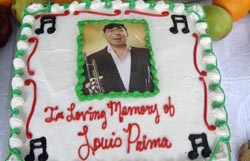
In addition to the hundreds of attendees who share in this town meal, those who must remain at home are served "from the altar," if arrangements are made in advance. Vincent Spitale and others deliver between twenty and fifty plates each year to those who are unable to visit the altar and take part in the festivities due to illness or other causes.
The following interpretation of the St. Joseph's day legend and description of the food on South Louisiana saints' tables was written by Faye Zuppardo, an early coordinator of the large public altar built each year by the Greater New Orleans Italian Cultural Society at the Piazza d'Italia at 300 Poydras Street in New Orleans. Various groups in Tangipahoa Parish reproduce this pamphlet and distribute it to those who visit their public altars. A portion of it is used by the organizers of the public altar in Independence.
"According to legend, the St. Joseph altar originated in Sicily, many centuries ago during a period of drought and famine. In desperation, the people turned to St. Joseph asking his help and intercession.
When the rains came and the crops prospered, their prayers were answered. In thanksgiving, the community made offerings to St. Joseph of their most prized possession, FOOD!
In his honor, they erected a lovely altar, with three levels to represent the Holy Trinity. They draped it simply and beautifully in white, adorned it with flowers. Then they selected their finest grain, fruits, vegetables, seafood, and wine and invited all the poor to share in their prayer and festivity.
The custom and devotion continue to this day. Each year, altars laden with food are prepared on March nineteenth to celebrate St. Joseph's Feast Day. Reasons for having the altars vary: to fulfill a promise; to give thanks for a favor granted, such as the return of a loved one from war; for healing the sick; for a happy family life; for success in studies or business. It is also an opportunity for the prosperous to share with those less fortunate. Preparations are made weeks in advance for the Great Day. Much hard work is involved, but participants, family and friends joyously accept this as a form of sacrifice and a labor of love.
Many hours are spent shaping and designing the elaborate loaves of bread and cookies which decorate the altar. Quite a number of these items are symbolic. The cuchidati, large golden-brown bread with a glossy finish of eggwash and sesame seeds, is rolled and cut into wreaths representing the crown of thorns, hearts symbolizing the Sacred Heart of Jesus and Mary, the Cross representing the crucifixion, the Chalice for water and wine, a Monstrance containing the host, St. Joseph's staff and beard, palms representing those strewn in Jesus' path in Jerusalem; Pupacoulova (baskets containing dyed eggs foretell the coming of Easter). There are fish, birds, flowers and whatever the artistic temperament dictates.
The cookies are everybody's favorites: fig cakes in many lovely patterns, large and small; biscotti, various shapes and sizes iced in colors of pink, green, white, yellow and chocolate, flavored with almond, vanilla, lemon, anise, and other spices. The pignolati, or GiGis, are pastry kernels molded with caramelized sugar into pyramids that represent the pine cones Jesus played with as a child. There are fluffy coconut bars and lambs, Bible-shaped layer cakes, cannoli and sfingi (Italian-style beignet).
In addition to all the wheat products, there is a great display of fruits, vegetables and a variety of seafood. No meat is ever served on a St. Joseph Altar, perhaps because the feast day occurs during the Lenten season or because there was always a scarcity of meat. The few goats and cattle were retained for their milk and cheese.
The altars groan under the weight of baked redfish, twelve fried whole trout (which are representative of Christ's feeding the multitudes; others claim this represents the twelve apostles). Shrimp, crabmeat and tuna are used in stuffed vegetables, such as green peppers, eggplant, squash, etc. Codfish (baccala), lobster, crawfish, and oysters also enhance the table.
Pasta Milanese is the leading entrée on the altar. The tomato sauce is made with a fish base, anchovy or fresh sardine, wild anise greens, pignola and currants topped with fried seasoned bread crumbs (modica) instead of cheese (The bread crumbs represent the sawdust of St. Joseph the carpenter.).
Most of the vegetables-finocchi, broccoli, spinach, green beans, cabbage, cauliflower-are prepared as frittata (omelets). Stuffed artichokes are a major attraction; the carduni (cardoon) are delicious boiled, then dipped in batter and fried.
The green fava bean is also served in a frittata or with a garlic sauce. When dried, roasted and blessed, it becomes the very popular 'lucky bean.' Legend has it that you will never be broke as long as you carry a lucky bean. This myth began during one of the famines in Sicily. The fava bean at that time was used as fodder for cattle. In order to survive, the poor farmers prepared them for their table. Thus, it became a 'lucky bean.' Today, it is considered a delicacy and used in numerous recipes.
A most important custom and a lovely one for the St. Joseph Day rites is that of having children enact the roles of the Holy Family-Jesus, Mary and Joseph. Sometimes angels or favorite saints are chosen to accompany them. A table is set especially for the children. They are served a very small portion of each food on the altar beginning with an orange segment and other fruits, lentil soup, pasta Milanese, fish, frittata, artichokes, olives, salad, cheese, eggs, bread, cookies, rice pudding, confetti (sugar-coated almonds), fig and sesame seed cakes.
This ritual is solemnly observed and usually accompanied by prayer and hymns. Guests dine after the Holy Family has completed their meal.
Then there is the age-old levity and joyful exchanges of camaraderie. The age-old expression is frequently used, 'May St. Joseph always smile upon you!'
The Altar to St. Joseph
Following the community meal and preceding the procession, the public altar is open for viewing, following the customary procedure of home altars. Altars traditionally comprise three tiers, though some altars use a multi-tiered "foundation," which also holds food, candles, medals, prayer cards and fava beans. Altars are built in various configurations, as long as they incorporate the traditional number of tiers and altar items and foods. Annie Accardo remembers that her mother built her altars in a "wagon wheel," the circular shape giving her more room on the tables. Many individuals build their altars to accommodate the shape of the room in which it is displayed. Altar themes and styles go in and out of fashion as well. Some years, altars with canopies over them may be popular; during the bicentennial, American flags were popular features of home altars.
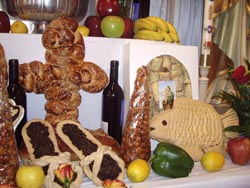
All items on the altar are blessed by a priest in a ceremony after the altar is completed, and before the altar is "broken"--before the foods are served or given to the needy. The altar always features a representation of St. Joseph at the center of the top tier, usually holding baby Jesus. Pastries and breads with symbolic meanings are interspersed with bottles of blessed non-sacramental wine (representing the miracle at Cana), fruit (oranges represent the fruit of Mary's womb; grapes and figs represent crops of Italy), olives and olive oil (also products of Italy), small vases containing uncooked spaghetti noodles, candles, flowers, and small statues of Joseph, Mary, and Jesus.
The breads are fashioned into ceremonial shapes before baking. The majority of the traditional shapes on an altar are the monstrance, or spada (vessel which holds the host), the chalice (representing wine served at the Last Supper), the cross, the dove (symbol of the Holy Spirit), the lamb (referring to Jesus as the lamb of God), the fish (the symbol of Christianity), hearts (representing the sacred hearts of Jesus and Mary), wreaths (symbols both of love and of Jesus' crown of thorns), the staff (Joseph's shepherd's crook), and palms (representing the palms laid at Jesus' feet as he entered Jerusalem on Palm Sunday, but sometimes also said to represent Mary). Some breads may be shaped to resemble instruments of the Passion or the tools of the carpenter's trade-ladders, hammers, etc. Still others may be fashioned into fanciful decorative shapes such as flowers and birds (especially doves, symbols of Christianity), the sun, moon, and stars, or other imaginative shapes. Fig breads are also molded and cut into these shapes for display on the altar.
Some of the pastries on the altar are a cake shaped and decorated as a large Bible, pignolata (small fried cookies with honey formed into pyramids, which represent pine cones Jesus might have played with as a child; individual pignolata are said to represent Mary's tears), sugar-coated almonds (representing the seed of the Holy Spirit), poppacalkova (pastry containing a dyed boiled egg, representing the coming of Easter and the beginning of spring), cannloi, sfinge di San Guiseppe (St. Joseph's Day cream puffs) biscotti, orange cookies, cherry cookies, fig cookies, chocolate cookies, snowball cookies, seed cookies, orange cookies (cookies represent Jesus', and the community's, concern for children), cencl'all fiorentina (also called bowknots, representing the community's strong tie to St. Joseph), scardalina (also called dead man's bones (representing the bones of those who suffer from hunger and thirst, both in long-ago Italy and in the present). A new feature of the past few public altars is the "rosary cake"-small decorated cakes "strung" together like rosary beads, with a cross at the end. Near the rosary cake sits a small statue of St. Joseph, upon whose sash visitors may pin donations toward the altar or for the poor.
Visitors to the altar are often given small keepsake bags containing a blessed medal, prayer card, fava bean, cookies, or bread. The easy-to-carry fava beans are often called "lucky beans" (because they have been blessed), and can be seen peeking out of many a wallet or coin purse in the grocery-store checkout line. "Saints" are also given a blessed candle.
All components of the public altar are paid for by donation. Donations of food come from businesses, individuals (who buy, or sometimes catch, their donation), and the cooks who prepare the dishes. Donations of money are solicited by a designated "beggar." Since 1985, this office has been filled by John Anthony Catalano, Sr., who grew up helping his grandmother build altars in her home. As the altar is being disassembled on the afternoon of St. Joseph's Day, some of the fanciful breads, cakes, and pastries are informally auctioned off. The proceeds, after the altar is paid for, will be donated to various charities, primarily a scholarship fund for Mater Dolorosa School.
The Procession
The altar ceremonies are followed by a procession, in which a statue of St. Joseph is carried through the streets, preceded by an altar boy carrying a cross and a priest who leads followers in prayer. This tradition has evolved from processions in Sicily that have their roots in ancient religious and even pre-Christian rites. Independence celebrants refer to the religious procession on the afternoon of March nineteenth as a "parade," though it demonstrates no secular elements. Independence natives, like many South Louisianans, simply refer to any organized procession as a parade.
In past days, women sometimes walked barefoot in the procession as an act of penitence, and a very few still do. It is not uncommon to see a woman bundled up in a fur coat with bare feet, or feet protected only by thin plastic bags, on a blustery St. Joseph's Day during the procession. Every so often, the procession will come to a halt as individuals make their "commitments," and confirm them by pinning money to the sash placed around the statue of St. Joseph. Buster Guzzardo recollects that years ago, older worshippers commonly gave gifts of thanks such as jewelry which would also be pinned to St. Joseph's sash.
John Anthony Catalano, Sr. says that when he was a boy as many as fifty altar boys would walk in the procession, which included several hundred people. Today it is uncommon for young people to take part in the parade. The procession, which still follows the traditional route, ends at the new Mater Dolorosa church, and prayers continue to be said in front of the church building for some time after the procession has ended. Mr. George Guzzardo has coordinated the procession for many years.
Sources
Baiamonte, John V., Jr. "Italians in Louisiana," in LLA Bulletin, volume 57, number 1, Summer 1994.
Becnel, Harry P. "Customs, Traditions, and Folklore of a Rural Southern Italian-American Community," in Folklife in the Florida Parishes, ed. Joel R. Gardner. Baton Rouge: Louisiana Division of the Arts, Office of Cultural Development, Department of Culture, Recreation, and Tourism. 1989.
Cole, Al. Viva San Guiseppe: A Guide for St. Joseph Altars. New Orleans: The St. Joseph Guild, 1200 Mirabeau Ave., N.O. LA 70122. 1985.
Del Guidice, Luisa. Preliminary Survey of Italian Folklife in Los Angeles, Los Angeles: Folk and Traditional Arts Program, Department of Cultural Affairs. 1990.
Muffoletto, Anna. The Art of Sicilian Cooking. New York: Doubleday. 1971.
Orso, Ethelyn. The St. Joseph Altar Traditions of South Louisiana. Lafayette: The Center for Louisiana Studies, University of Southwestern Louisiana. 1990


